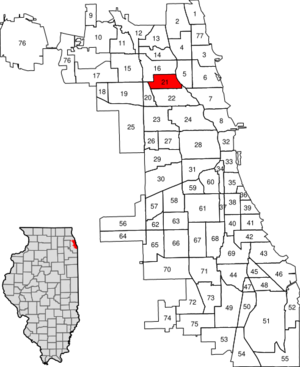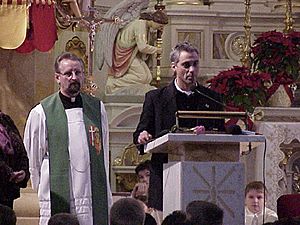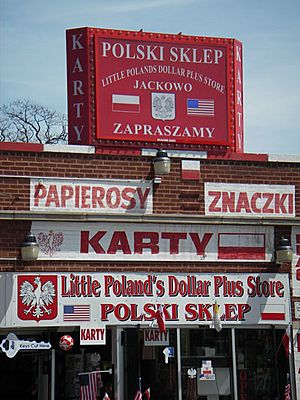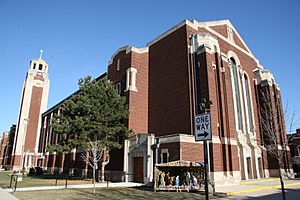Avondale, Chicago facts for kids
Quick facts for kids
Avondale
|
|
|---|---|
| Community Area 21 - Avondale | |

St. Hyacinth Basilica towers over the Avondale neighborhood.
|
|

Location within the city of Chicago
|
|
| Country | United States |
| State | Illinois |
| County | Cook |
| City | Chicago |
| Neighborhoods | |
| Area | |
| • Total | 2.00 sq mi (5.18 km2) |
| Population
(2020)
|
|
| • Total | 36,257 |
| • Density | 18,128/sq mi (6,999/km2) |
| Demographics 2018 | |
| • White | 34.75% |
| • Black | 1.96% |
| • Hispanic | 57.12% |
| • Asian | 3.74% |
| • Other | 2.43% |
| Educational Attainment 2018 | |
| • High School Diploma or Higher | 78.44% |
| • Bachelor's Degree or Higher | 35.18% |
| Time zone | UTC-6 (CST) |
| • Summer (DST) | UTC-5 (CDT) |
| ZIP Codes |
60618
|
| Median household income | $60,000 |
| Source: U.S. Census, Record Information Services | |
Avondale (/ˈævəndeɪl/) is a vibrant neighborhood in Chicago, Illinois. It is one of the city's 77 official community areas. You can find Avondale on the Northwest Side of Chicago.
Its northern boundary is Addison Street, stretching from the north branch of the Chicago River to Pulaski Road. The neighborhood also reaches west along Belmont Avenue to the Union Pacific/Northwest Line. To the south, Diversey Avenue forms the border, from the Union Pacific/Northwest Line to the Chicago River.
Contents
Avondale's History
How Avondale Began
The first European settler in Avondale was Abraham Harris. He arrived in the area around 1853. In 1869, Avondale became its own village. Some people believe it was named by John Lewis Cochran. He might have chosen the name to honor miners who died in a coal mine fire in Avondale, Pennsylvania.
What was special about Avondale back then? It was racially integrated in the 1800s. About twenty African American families moved there. They even built Avondale's first church in the 1880s. In 1889, Avondale officially became part of the City of Chicago.
Growth and Industry
Around the early 1900s, many factories and businesses started in Avondale. This was because of the Chicago River and good transportation. In the 1870s, many roads and train lines were built. After joining Chicago, these improved even more. Old cable cars were replaced with electric streetcars.
These new jobs brought many European immigrants to the area. Avondale was also home to the Olson Park and Waterfall complex. This was a famous garden and waterfall at Diversey and Pulaski. It was even called one of Chicago's "Seven Lost Wonders."
New Cultures and Changes
Starting in the 1980s, more Latino families began to settle in Avondale. After 1989, when Communism ended in Eastern Europe, many different groups arrived. These included people from Poland, Czech Republic, Slovakia, Ukraine, and Belarus. This mix of cultures gave Avondale its nickname: "Where Eastern Europe meets Latin America."
In the mid-2000s, Avondale started to experience gentrification. This is when an older neighborhood becomes more popular and expensive. This change also happened in nearby areas like Wicker Park and Logan Square.
Who Lives in Avondale?
Avondale has always had a large Polish population. There were also groups of German, Scandinavian, and Italian settlers. In recent years, the neighborhood has become even more diverse. After Communism ended in Eastern Europe, many new immigrants arrived. These included Czechs, Slovaks, Ukrainians, and Belarusians.
There's also a strong Filipino community in Avondale. The neighborhood is home to Chicago's Filipino TV station. Starting in the 1980s, more Latino families moved in. This led to a big increase in the Hispanic population. Many people came from Mexico, Puerto Rico, and Central America.
Recently, due to gentrification, the number of non-Hispanic white residents has grown faster. This has changed the population mix again.
Getting Around Avondale
Train and Bus Options
Avondale is well-connected by public transportation. You can use Chicago's 'L' train system. The Blue Line has two stations in Avondale. The Belmont station is near the Kennedy Expressway. The Addison station is also right next to the expressway.
Many CTA bus routes also serve Avondale:
- Northwest/Southeast routes:
* 56 Milwaukee
- North/South routes:
* 49 Western * 52 Kedzie/California * 53 Pulaski * 82 Kimball-Homan * 94 California
- East/West routes:
* 76 Diversey * 77 Belmont * 152 Addison
Neighborhoods within Avondale
The Polish Village

The Polish Village is a lively area in Avondale. It is also known by its Polish names, Jackowo and Wacławowo. These names come from two important Polish Catholic churches nearby. They are Saint Hyacinth's Basilica and St. Wenceslaus Church.
Milwaukee Avenue is the main street here. You can find many Polish shops, restaurants, and bakeries. The area is often called the "Polish Village" on street signs. Pulaski Avenue, named after a Polish hero, also runs through this neighborhood.
Polish communities grew here in the late 1800s and early 1900s. The Polish Village was very active in the 1980s and 1990s. Many Polish immigrants and refugees came to Chicago then. For a long time, the train drivers would even announce "Yats-koh-voh" for the St. Hyacinth Basilica stop.
The historic Milford Theatre used to be a Polish movie theater. It was called "Cinema Polski" by locals. A famous street photographer, Vivian Maier, even took pictures here.
This area was important for Polish arts and culture. People could freely express themselves here. The activities in Chicago's Polish community helped lead to the end of Communism in Poland. A mural by Caryl Yasko called "Razem" (meaning "Together") was painted in 1975. It shows Polish pride and culture. You can still see it near Belmont and Pulaski.
Just north of Jackowo is Wacławowo. This area has many brick two-flats and bungalows built before World War II.
Belmont Gardens
Belmont Gardens is a neighborhood that crosses two Chicago community areas: Logan Square and Avondale. It is located in the northwest part of Avondale. The main borders of Belmont Gardens are Pulaski Road to the east, the Union Pacific/Northwest rail line to the west, Belmont Avenue to the north, and Fullerton Avenue to the south.
In the 1880s, much of this land was empty farmland. This changed when it became part of Chicago in 1889. This was in preparation for the World's Columbian Exposition in 1893.
The first urban development in Belmont Gardens was by Homer Pennock. He wanted to create an industrial and residential area called Pennock, Illinois. However, his plans did not work out. By 1903, the Chicago Tribune called it "A Deserted Village in Chicago."
Even though Pennock's plan failed, Chicago grew quickly. The farms turned into factories and homes. In the early 1900s, Belmont Gardens was part of the "Polish Corridor." This was a long stretch of Polish settlement along Milwaukee Avenue.
Belmont Gardens was attractive because it was less crowded. It also had good access to rail lines. This led to many industries developing in the area. It is still part of the city's Pulaski Industrial Corridor today. Near his factory, Mr. Walter E. Olson built the famous Olson Park and Waterfall Complex. This was a 22-acre garden and waterfall. It was a popular spot for family trips.
Latino families started moving into the neighborhood in the 1980s. Today, Belmont Gardens still feels like a working-class neighborhood. This is even as other parts of Logan Square and Avondale become more gentrified.
Kosciuszko Park Neighborhood
Kosciuszko Park is another neighborhood that spans both Logan Square and Avondale. Locals often call it "Koz Park" or "Land of Koz." This area shows how green spaces can help create a strong community identity.
The boundaries of Kosciuszko Park are generally Central Park Avenue to the east, Pulaski Road to the west, George Street to the north, and Altgeld to the south.
Like Belmont Gardens, this area was mostly farmland in the 1880s. It became part of Chicago in 1889. This was part of the city's growth before the World's Columbian Exposition.
Homer Pennock also tried to develop this area. His plan for an industrial village called Pennock, Illinois, did not succeed. The Chicago Tribune even wrote about it as "A Deserted Village in Chicago" in 1903.
Despite this, Chicago's growth turned the farms into factories and homes. In the early 1900s, Kosciuszko Park was also part of the "Polish Corridor." This was a continuous area of Polish settlement along Milwaukee Avenue. The neighborhood's closeness to rail lines helped many industries grow.
Near Kosciuszko Park, you can find St. Hyacinth Basilica. It started in 1894 as a place for spiritual needs. The church has relics linked to Pope John Paul II. Other Polish institutions also grew here. In 1897, the Polish Franciscan Sisters built St. Joseph Home for the Aged and Crippled. This was Chicago's first Catholic nursing home.
The park itself, dedicated in 1916, gave the neighborhood its name. It is named after the Polish patriot Tadeusz Kosciuszko. He is famous for designing and building West Point and fighting in the American Revolution. The park was part of a plan to have a park for every ten square miles. Architect Albert A. Schwartz designed the park's Tudor revival-style fieldhouse.
The park quickly became a center for community events. Residents used it for bonfires, festivals, and celebrations. In winter, there was often an ice skating rink. In summer, people enjoyed sports, dancing, and music. Sometimes, the city's "mobile zoo" would even visit!
Today, "The Land of Koz" is a very diverse neighborhood. It continues to welcome new residents. The park still serves as a place for the community to come together. People play, perform, and even watch outdoor movies there.
Avondale's Economy
In 1937, the popular drink Dad's Root Beer was started in Avondale. The company had a bottling plant here before moving its operations. That old factory is now apartments.
As of 2014, the main jobs in Avondale are in retail (stores), manufacturing (making things), and utilities (like electricity and water). Many workers come from outside Avondale. For residents, the top jobs are in food service, healthcare, and professional services.
Schools in Avondale
Students in Avondale attend Chicago Public Schools. These include local neighborhood schools and special citywide schools. There are also private Catholic schools run by religious groups.
Carl Von Linne School is a neighborhood school. It offers programs for gifted students and a dual language program. The school focuses on fine arts like visual arts, music, and dance. It also has two gardens for students to learn about growing food.
The United Neighborhood Organization also runs the Carlos Fuentes School in Avondale.
Public Libraries
The Chicago Public Library does not have a branch directly in Avondale. However, you can find branches nearby in neighborhoods like Logan Square, Irving Park, and Belmont Cragin.
Parks in Avondale
Avondale has been called one of Chicago's "park poor" neighborhoods. This means it has fewer parks compared to other areas. For example, Avondale Park became much smaller when the Kennedy Expressway was built. The expressway took over most of its green space, including playfields and tennis courts.
The main green spaces in Avondale are Brands Park and Avondale Park. Residents also use nearby parks like Kosciuszko Park, Athletic Field Park, and Ken-Well Park. There are also smaller playlots in Avondale, such as Grape Playlot and Nelson Playlot.
Avondale's Culture
Avondale is known for its strong and diverse cultural centers. The St. Hyacinth Basilica is a very important place for Chicago's Polish Community. Living up to its nickname, "where Eastern Europe meets Latin America," Avondale is also home to the new Puerto Rican Arts Alliance location. This is in a former firehouse.
The Hairpin Arts Center is also in Avondale. It is near the border with Logan Square and the Polish Village. This center serves all the different communities living in these neighborhoods.
Notable People from Avondale
- Vivian Maier: A famous photographer who took many pictures in Chicago's Polish Village.
- Lucy Parsons: A labor organizer and founder of the Industrial Workers of the World.
- Carlos Ramirez-Rosa: A member of the Chicago City Council. He is the first openly gay, Latino alderman.
- Louise Schaaf: She was the oldest person in Illinois and the oldest known person born in Germany when she passed away in 2020.
See Also
Images for kids
-
Rahm Emanuel speaking at St. Hyacinth Basilica.








